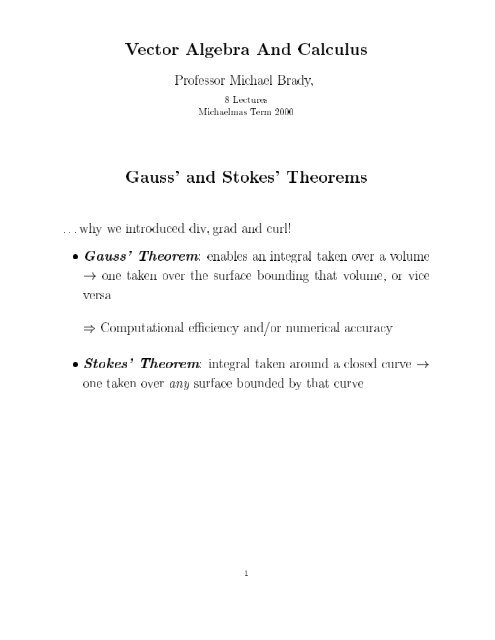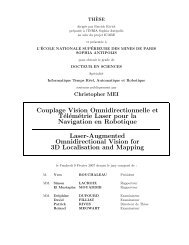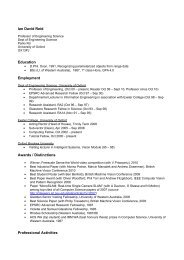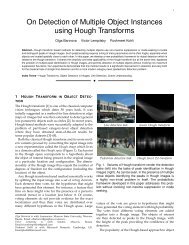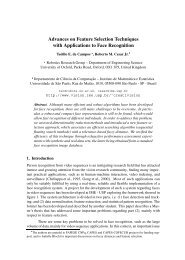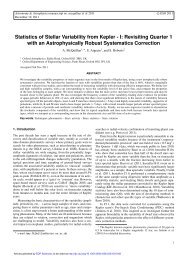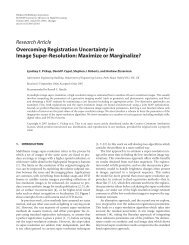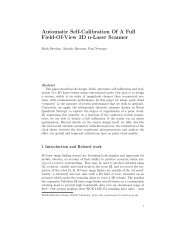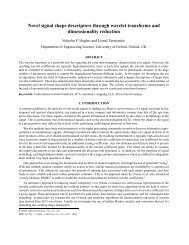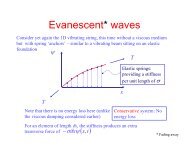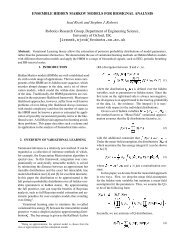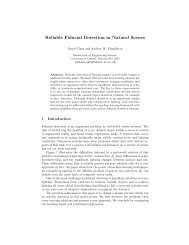Vector Algebra And Calculus Gauss' and Stokes' Theorems
Vector Algebra And Calculus Gauss' and Stokes' Theorems
Vector Algebra And Calculus Gauss' and Stokes' Theorems
Create successful ePaper yourself
Turn your PDF publications into a flip-book with our unique Google optimized e-Paper software.
<strong>Vector</strong> <strong>Algebra</strong> <strong>And</strong> <strong>Calculus</strong><br />
Professor Michael Brady,<br />
8 Lectures<br />
Michaelmas Term 2000<br />
<strong>Gauss'</strong> <strong>and</strong> <strong>Stokes'</strong> <strong>Theorems</strong><br />
...whyweintroduced div; grad <strong>and</strong> curl!<br />
<strong>Gauss'</strong> Theorem: enables an integral taken overavolume<br />
! one taken over the surface bounding that volume, or vice<br />
versa<br />
) Computational eciency <strong>and</strong>/or numerical accuracy<br />
<strong>Stokes'</strong> Theorem: integral taken around a closed curve !<br />
one taken over any surface bounded by that curve<br />
1
<strong>Gauss'</strong> Theorem<br />
Suppose a(r) isavector eld.<br />
we want to compute its ux of the eld across the surface S that<br />
bounds a volume V :<br />
Z<br />
S a dS = Z S a ^ndS<br />
where ^n is the unit surface normal on S.<br />
<strong>Gauss'</strong> Theorem:<br />
ZS a ^ndS = Z<br />
V<br />
div adV<br />
2
Example of <strong>Gauss'</strong> Theorem<br />
Suppose a = z 3 k <strong>and</strong> that S is the sphere of radius R centred on<br />
the origin.<br />
On the surface of the sphere, a = R 3 cos 3 k;dS = R 2 sin dd^r<br />
<strong>and</strong> ^r k = cos . We nd:<br />
ZS adS = Z 2<br />
Z <br />
=0 =0 Z R3 cos 3 R 2 sin dd cos <br />
= 2R 5 <br />
0 cos4 sin d<br />
= 2R5 [, cos 5 ] 0<br />
5<br />
= 4R5<br />
5<br />
It was \lucky" that we arranged the angle integral to come out so<br />
nicely!<br />
3
Applying <strong>Gauss'</strong> Theorem<br />
To apply <strong>Gauss'</strong> Theorem, we need to gure out div a <strong>and</strong> decide<br />
how to compute the volume integral. The rst is easy:<br />
diva =3z 2<br />
For the second, we can divide the sphere into discs of constant z<br />
<strong>and</strong> thickness dz. Then<br />
<strong>and</strong><br />
dV = (R 2 , z 2 )dz<br />
ZV div adV = 3 Z R<br />
= 3<br />
= 4R5<br />
5<br />
2<br />
64 R2 z 3<br />
,R z2 (R 2 , z 2 )dz<br />
3<br />
, z5<br />
5<br />
3<br />
75 R ,R<br />
This is a typical example: the surface integral is rather tedious,<br />
whereas the volume integral is straightforward.<br />
imagine how complex the surface integral might become over truly<br />
hairy surfaces. Breaking up the enclosed volume into tiny elements<br />
often makes the computation far easier, faster, <strong>and</strong> better conditioned<br />
numerically.<br />
4
Extension to <strong>Gauss'</strong> Theorem<br />
Suppose a = U c but where for present purposes c is a constant<br />
vector, then<br />
div a = Udiv c + gradU c<br />
Since c is assumed constant, divc = 0 <strong>and</strong> <strong>Gauss'</strong> Theorem<br />
becomes<br />
Z<br />
S U(c dS) =Z (gradU c)dV<br />
V<br />
taking the constant c out of the integrals<br />
c Z S UdS <br />
= c <br />
Z<br />
V gradUdV <br />
This is still a scalar equation but we now note that the vector c<br />
is arbitrary so that the result must be true for any vector c. This<br />
can be true only if the vector equation<br />
ZS UdS = Z<br />
V gradUdV<br />
5
Example of extension to <strong>Gauss'</strong> Theorem<br />
Suppose that U = x 2 + y 2 + z 2 <strong>and</strong> V is the cylinder x 2 + y 2 <br />
a 2 ; 0 z h.<br />
6
evaluating the surface integral<br />
Z<br />
S UdS<br />
from symmetry that there is no contribution from the curved surface<br />
of the cylinder since for every vector surface element there<br />
exists an equal <strong>and</strong> opposite element with the same value of U.<br />
We therefore need consider only the top <strong>and</strong> bottom faces.<br />
Top face:<br />
Z<br />
UdS =<br />
Z a<br />
Bottom face:<br />
U = x 2 + y 2 + h 2 = r 2 + h 2 <strong>and</strong> dS =2rdrk<br />
0 (h2 +r 2 )2rdrdk = k<br />
2<br />
4 h 2 r 2 + 1 2 r4 3 5<br />
a<br />
0<br />
= [h 2 a 2 + 1 2 a4 ]k<br />
U = r 2 <strong>and</strong> dS = ,2rdrk<br />
The contribution from this face is thus , a4 k, <strong>and</strong> the total integral<br />
is h 2 a 2 2<br />
k.<br />
7
Applying <strong>Gauss'</strong> Theorem<br />
we have to compute<br />
Z<br />
V<br />
grad UdV<br />
In this case, gradU =2r, so that the i <strong>and</strong> j components are zero<br />
by symmetry.<br />
The k component gives<br />
Z h<br />
0 2za2 dz = a 2 h 2 k<br />
8
<strong>Stokes'</strong> Theorem<br />
<strong>Stokes'</strong> Theorem relates a line integral around a closed path to a<br />
surface integral over what is called a capping surface of the path.<br />
Imagine that the closed path is a bent, originally circular, piece of<br />
wire. There is no requirement for the distorted wire to be planar.<br />
Now let a bubble hang from the wire. The surface of the bubble is<br />
a capping surface. We can choose the capping surface as we wish.<br />
<strong>Stokes'</strong> Theorem:<br />
IC a dl = Z<br />
S<br />
curl adS<br />
where S is any surface capping the curve C.<br />
9
Example of <strong>Stokes'</strong> Theorem<br />
Suppose a = x 3 j , y 3 i <strong>and</strong> C is the circle of radius R centred on<br />
the origin. We want to compute:<br />
On the circle,<br />
I<br />
C a dl<br />
<strong>and</strong><br />
a = R 3 (, sin 3 i + cos 3 j)<br />
dl = Rd(, sin i + cos j) :<br />
IC a dl = Z 2<br />
0<br />
R 4 (sin 4 + cos 4 )d = 3 2 R4 ;<br />
since<br />
Z 2<br />
0<br />
Z sin 4 2<br />
d = cos 4 d = 3 0<br />
4<br />
10
Applying <strong>Stokes'</strong> Theorem<br />
the surface integral requires that curl a be computed. This is<br />
i j k<br />
curl a =<br />
<br />
@<br />
@x<br />
@<br />
@y<br />
@<br />
@z<br />
,y 3 x 3 0<br />
<br />
=3(x 2 + y 2 )k =3r 2 k<br />
We choose area elements to be circular strips of radius r thickness<br />
dr. Then<br />
dS =2rdrk<br />
<strong>and</strong> Z S curl a dS =6 Z R<br />
0 r3 dr = 3 2 R4<br />
11
Extension to <strong>Stokes'</strong> Theorem<br />
suppose a = U c, where c is a constant vector, so that<br />
curl a = Ucurl c + gradU c<br />
Again, curl c is zero. <strong>Stokes'</strong> Theorem becomes in this case:<br />
I<br />
C U(c dl) =Z S (gradU c dS = Z S<br />
c (dS gradU)<br />
rearranging the triple scalar products <strong>and</strong> taking the constant c<br />
out of the integrals gives<br />
c I C Udl = ,c Z S<br />
gradU dS<br />
since c is arbitrary, we nd the vector equation:<br />
I<br />
C Udl = , Z S<br />
gradU dS<br />
12
Example of extension to <strong>Stokes'</strong> Theorem<br />
Consider the case where U = x 2 + y 2 + z 2 <strong>and</strong> C is the circle<br />
(x , a) 2 + y 2 = a 2 ;z =0. We have to compute:<br />
I<br />
C Udl<br />
Doing this directly, we note the i component is zero by symmetry<br />
<strong>and</strong> there is no k component. On the circle<br />
U = a 2 (1 + cos ) 2 + a 2 sin 2 =2a 2 (1 + cos )<br />
dl<br />
= ad(cos j , sin i);<br />
so that<br />
I<br />
Udl =2a<br />
3 Z 2<br />
0<br />
(1 + cos )(cos j , sin i)d =2a 3 j<br />
13
applying <strong>Stokes'</strong> Theorem<br />
On the other h<strong>and</strong>, over the area of the circle dS = rdrdk, since<br />
r 2 =(x , a) 2 + y 2 ) <strong>and</strong><br />
so that<br />
gradU =2r =2(a + r cos )i +2r sin j<br />
dS gradU =[,2r sin i +2(a + r cos )j]rdrd<br />
<strong>and</strong><br />
ZS dS gradU =4j Z a<br />
r=0<br />
Z 2<br />
=0 2ardrd =2a3 j<br />
14
Fluid Mechanics - The Continuity Equation<br />
Expression of conservation of mass in a uid ow. The continuity<br />
principle applied to any volume (called a control volume) may<br />
be expressed in words as follows:<br />
" The net rate of mass ow of uid out of the control<br />
volume must equal the rate of decrease of the mass of<br />
uid within the control volume"<br />
denote the velocity of the uid at each point of the ow by q(r),<br />
the density by (r), then rate of ow of mass out of the control<br />
volume is given by the integral over the surface S of the control<br />
volume<br />
Z<br />
S<br />
q dS:<br />
15
The Continuity equation<br />
using <strong>Gauss'</strong> Theorem, this is<br />
Z<br />
div(q)dV<br />
V<br />
rate of decrease of mass contained in the control volume is:<br />
, @ @t<br />
Z<br />
V dV<br />
Assuming volume of interest is xed, this is equal to<br />
, Z V<br />
@<br />
@t dV:<br />
The two volume integrals can be equal for any control volume V<br />
only if the two integr<strong>and</strong>s are equal at each point of the ow.<br />
the Continuity Equation:<br />
div(q) =, @<br />
@t<br />
for a uid of constant density, div q =0:<br />
16
The Heat Conduction Equation<br />
Flow of heat similar to uid ow, so heat ow satises a similar<br />
continuity equation.<br />
heat ow ischaracterized by its \current density" q(r) (heat<br />
ow per unit area <strong>and</strong> time)<br />
assuming no mass ow across the boundary of the control volume,<br />
<strong>and</strong> no source of heat inside it, the rate of ow of heat<br />
out of the control volume by conduction must equal the rate<br />
of decrease of internal energy (constant volume) or enthalpy<br />
(constant pressure) within it<br />
div q = ,c @T<br />
@t ;<br />
where is the density of the conducting medium, c its specic heat<br />
(both are assumed constant) <strong>and</strong> T is the temperature.<br />
17
the heat conduction equation<br />
to solve for the temperature eld another equation is required,<br />
linking q to the temperature gradient. This is<br />
q = ,kgrad T;<br />
where k is the thermal conductivity of the medium. Combining<br />
the two equations gives<br />
heat conduction equation:<br />
,divq = kdiv grad T = kr 2 T = c @T<br />
@t<br />
where it has been assumed that k is a constant. In steady ow the<br />
temperature eld satises Laplace's Equation r 2 T =0.<br />
18
Conservative elds of force<br />
A conservative eld of force dened as one for which the work<br />
done in moving between two points in the eld is independent of<br />
the path taken.<br />
the work done is:<br />
Z B<br />
A<br />
F dl;<br />
where A <strong>and</strong> B are the initial <strong>and</strong> nal points <strong>and</strong> F(r) is the force<br />
eld.<br />
Since any two dierent paths between A <strong>and</strong> B together make up<br />
a closed curve C, we see that a conservative eld must satisfy the<br />
condition<br />
using <strong>Stokes'</strong> theorem:<br />
I<br />
Z<br />
C<br />
S<br />
F dl =0;<br />
curlF dS =0;<br />
where S is any surface bounded by C.<br />
The only way this equation can be satised for any C is for the<br />
integr<strong>and</strong> to be zero at every point:<br />
So: curlF =0: aconservative eld of force must be irrotational.<br />
the only way is for the force eld to be the gradient of a scalar<br />
eld U, called the potential function, i.e F = ,rU.<br />
19
Inverse Square Law of force<br />
One reason why there are lots of inverse square laws in nature<br />
may be because it is the only central force eld which has zero<br />
divergence:<br />
If F = f(r)r have zero divergence,<br />
Since div F =0we conclude<br />
divF =3f(r) +rf 0 (r):<br />
r df<br />
dr +3f = 0<br />
df<br />
f +3dr = 0<br />
r<br />
Integrating wrt r gives fr 3 = const = A, so that<br />
F = Ar<br />
r 3 ; jFj = A r 2:<br />
note, by symmetry, that any central eld of force is also irrotational.<br />
20
down the plughole...<br />
div F = 0 applies everywhere except at the origin, where the<br />
divergence is innite.<br />
illustration: calculate the outward normal ux out of a sphere of<br />
radius R centered on the origin. This is clearly equal to 4R 2 F =<br />
4A , i.e. a constant, independent of radius. Since this ux must<br />
be equal to<br />
Z R<br />
0 divF 4r2 dr;<br />
so: no contribution to integral from any point except the origin,<br />
<strong>and</strong> by letting R tend to zero we see that divF must be innite at<br />
the origin.<br />
21
Gravitational eld due to distributed mass<br />
Poisson's Equation<br />
gravitational eld: A = Gm, where m is the mass at the origin<br />
<strong>and</strong> G the universal gravitational constant.<br />
mass in volume element dV is dV , giving ,4GdV to the ux<br />
integral from the control volume<br />
Z<br />
S F dS = ,4GZ dV: V<br />
<strong>Gauss'</strong> Theorem gives:<br />
Z<br />
div FdV = ,4GZ dV<br />
V V<br />
true for any V ,so<br />
,div F =4G:<br />
Since gravitational eld is also conservative (i.e. irrotational) it<br />
must have an associated potential function U, so that F = gradU.<br />
So:<br />
Poisson's equation:<br />
r 2 U =4G<br />
22
gravitational eld inside a spherical body<br />
recall that:<br />
Z<br />
S F dS = ,4GZ V dV:<br />
can calculate the gravitational eld inside a spherical body whose<br />
density is a function of radius only.<br />
where F = jFj, or<br />
4R 2 F =4G Z R<br />
0 4r2 dr;<br />
jF j = G R 2 Z R<br />
0 4r2 dr = MG<br />
R 2 ;<br />
where M is the total mass inside radius R. For the case of uniform<br />
density, this is equal to M = 4 3 R3 <strong>and</strong> jF j = 4 3 GR.<br />
23
Pressure forces in non-uniform ows<br />
a body immersed in a ow experiences a net pressure force<br />
Z<br />
F p = , pdS; S<br />
where S is the surface of the body. If the pressure p is non-uniform,<br />
this integral is not zero.<br />
transforming using <strong>Gauss'</strong> Theorem:<br />
F p = , Z V<br />
gradp dV;<br />
In the simple hydrostatic case p + gz = constant:<br />
gradp = ,gk<br />
<strong>and</strong> the net pressure force is simply<br />
F p = gk<br />
Z<br />
V dV<br />
which, in agreement with Archimedes' principle, is equal to the<br />
weight of uid displaced.<br />
24


